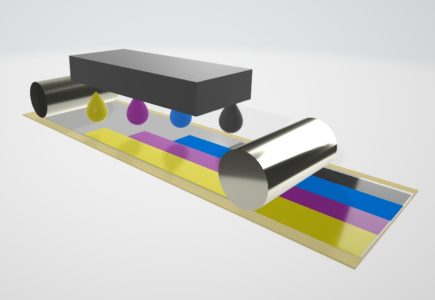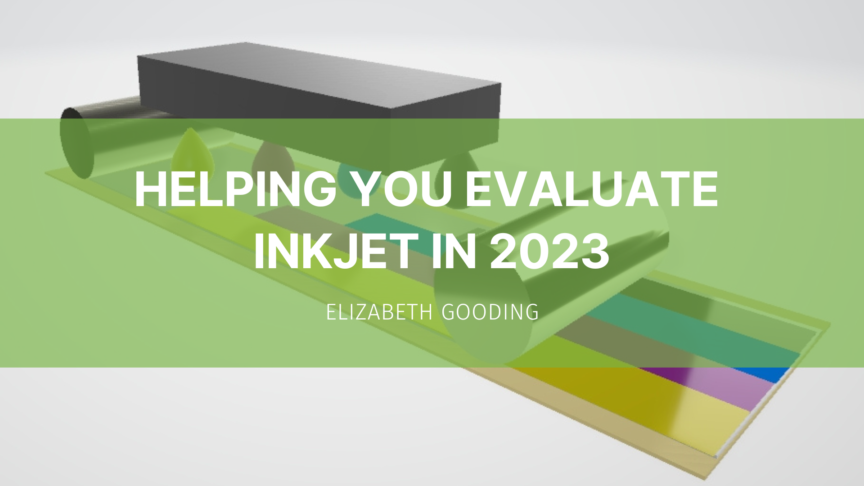A lot has changed since Inkjet Insight was launched back in 2017, but our mission hasn’t. Our goal is still to help companies evaluate, optimize and grow their businesses using inkjet. Let’s take a look at the evaluate part of that mission and highlight some of the supporting content that you may have missed.
Companies that are evaluating production inkjet presses need to consider a host of factors to ensure they are selecting the best technology and equipment for their specific needs. Even if you’ve done this before, it’s good to step back and make sure that you are checking all of the boxes objectively.
Here are some of the most important topics to research and links to more helpful information and downloadable tools.

Topics, tips and technology primers
- Printhead technology: consider the different types of printheads available, such as thermal, piezoelectric and continuous, to understand the advantages and limitations of each technology and determine which is best suited for your specific application.
-
- To learn the fundamentals of printheads, watch “Inkjet Head Technology Explained” with Mary Schilling and Mark Bale.
- If you are building a press or going hybrid, read “Five Questions to Ask When Buying Inkjet Heads.”
- Ink chemistry and formulation: ink chemistry and formulation is critical for inkjet printing, and companies often research different types of inks available, such as solvent-based, water-based and UV-curable, to understand the advantages and limitations of each and determine which is best suited for their specific application.
-
- For an overview of categories of ink chemistries, read “Inkjet ink – Chemistry Matters” and “Carrier Matters.”
- You may also be interested in adding security or invisible inks.
- Substrate compatibility: companies often research the range of substrates that can be used with different inkjet presses and inks, as well as the best practices for preparing and handling those substrates to ensure optimal print quality. We have many resources to help understand the general range of compatibility and how OEMs qualify substrates.
-
- Check out the replay of “Understanding Inkjet Media Qualification.”
- Find out what inkjet users say about the substrate approval process and how to work with OEMs to improve the process in “Production Inkjet Market Survey on Print Quality Measurement and Paper Qualification”
- If you are looking for more unusual media to print on, check out “I didn’t think you could do that with inkjet.”
- Overall print quality: companies should look carefully at the print quality, resolution and color capabilities of different inkjet presses, and compare them with printing methods currently used. This requires an objective, measurable view of quality factors. Since our cofounder, Mary Schilling is an internationally renowned expert on print quality management, this is an area where our content goes deep. We also benefit from the hands-on expertise of Mike Todryk of IWCO Direct.
-
- When in the evaluation process, start by understanding the “Components of Inkjet Print Quality.”
- Make sure you understand how Media affects perceived resolution.
- Make use of a fingerprint file to create a benchmark for presses being considered, and to track consistency during installation and production. Download free files here.
- Productivity and Speed: companies research the productivity and speed of the presses, including the maximum print speed, the number of printheads, and the maximum resolution to get an idea of what they can achieve with the press.
-
- You can compare the speeds of different presses on Device Finder
- But consider that some presses will deliver different print quality at different speeds
- It’s also important to consider overall productivity rather than just potential speed.
- Maintenance and uptime: companies should research the maintenance requirements of different inkjet presses, and evaluate the ease of maintenance and the availability of replacement parts, to ensure maximum uptime and minimize downtime.
-
- If you want to objectively compare the impact of even small differences in uptime, check out our downtime calculator.
- Total cost of ownership: understanding the total cost of ownership of different inkjet presses, taking into account factors such as the cost of the press, the cost of ink and other consumables, and the cost of maintenance and repairs, to determine the most cost-effective option.
-
- Check out our three part series on Inkjet Economics
- Software and Automation: take time research the software and hardware automation options available to control, monitor, and optimize the inkjet printing process, both in terms of improving quality and productivity, as well as streamlining and automating the workflow.
-
- Check out the RFP Checklist for Software Requirements
- Also consider the value of automating winding and splicing as well as inline finishing and post coating.
Beyond Technology
Don’t forget to evaluate the stability and reputation of the potential suppliers. Companies tend to leap frog each other with technology and they also have ups and downs with financials, staffing and customer support.
- Financial stability: research the financial stability of a supplier, including looking at financial reports, credit ratings, and any information available on the supplier’s financial performance. This will give an indication of the supplier’s ability to meet their financial obligations and to invest in their business over the long term.
- Industry reputation: research the supplier’s reputation within the industry, by talking to other companies that have used their products or services, and by reading industry publications and online reviews (like Inkjet Insight). This will give an indication of the supplier’s reputation for quality, reliability, and customer service. You can find interviews with many OEM executives as well as customers on Inkjet Insight.
- Experience in the market: consider how long they have been operating in the market and the number of successful installations they have completed. This will give an indication of their experience and ability to provide solutions that meet the specific needs of your market.
- Service and Support: gain an understanding of location, depth and training of support staff as well as support policies and stocking of replacement parts. This will give an indication of the supplier’s ability to provide technical support and troubleshoot any issues that may arise. Learn about remote support options and how OEMS are leveraging technology to provide more responsive service.
Covering all of these topics will help make and support your decision when choosing an inkjet press, and ensure it is the right fit for your specific needs. We’ve touched on a few example of the supporting materials available to help in the evaluation process, but we are continually updating. Try searching the Knowledge Base by topic to learn more, or walk through our series of Inkjet Explainers for a baseline on inkjet terminology.
For those who already own inkjet, we’re also here to help you optimize your operations and grow your business. Stay tuned for more insight in 2023.

